Internet advertising is a set of tools for delivering promotional messages to people worldwide, using the Internet as a global marketing platform.
As web technologies evolved in the 1990s, internet advertising appeared as a virtual equivalent to traditional marketing methods like TV and radio ads, newspaper advertising, billboards, etc. In 2019 marketers expect that companies will spend more money on digital advertising than on traditional ads.
Let’s find out why online advertising has become so popular and explore its most commonly used types — search engine marketing, email marketing, social media advertising, display ads, native advertising, and more.
Internet Advertising Advantages and Disadvantages
There are more than four billion internet users all over the world. This gives a huge boost to internet advertising. People look for products by using search engines, following their favorite brands in social media, and subscribing to their campaigns via email and push notifications. Advertising opportunities are enormous, but using them correctly is not that easy. So, let's have a closer look at the advantages and disadvantages of internet advertising.
Advantages of internet advertising
- Easy global coverage. Nowadays, people have a habit of searching for information about products and services via search engines like Google, Bing, and others. Internet advertising is a way to demonstrate your offers in front of over 4 billion web users around the globe. You can easily target the entire world via the Internet.
- Affordable for any budget. According to Seriously Simple Marketing, the minimum cost to reach an audience of 2,000 is three times cheaper than traditional advertising methods, so any company from a small family business to a huge enterprise can utilize online ads and get the most out of their financial resources.
- Drives traffic to a website. The more visitors you get to the site, the more potential customers you have, which will result in increased sales. Internet advertising aims to attract users’ attention and send them to your website. The offers displayed in the digital ads should arouse curiosity and give people a good reason for clicking through your site.
- Allows targeting. Unlike traditional marketing media that advertises to everyone without filtering, internet advertising tailors the message to a specifically targeted audience — people who are most likely to convert into customers. For instance, a travel equipment company may use social media ads for advertising to users who are keen on travel, encouraging likes and shares.
- Enables retargeting. Internet advertisements are a way to say, “hey, looks like a couple of days ago you checked out this toaster. I’ve got a marvelous one for you here!” If many prospects visit your household appliances online store without buying anything, remind them about your brand with banner ads displayed on websites they browse.
- It allows you to create various touchpoints with your audience. Internet advertising helps you to appear in the right place at the right time to communicate with your audience. If you own a small bakery, use socials like Instagram and Pinterest to demonstrate the products. To share news, and build long-lasting relationships with your audience, reinforce them with email marketing. By mixing different types of digital advertising wisely, you can show that your company is always present and ready to be of service.
- It is measurable. Unlike offline marketing, where the cost and effectiveness are somewhat approximate, you can precisely track the return on your efforts and internet marketing efficiency with web analytics platforms like Google Analytics.
Disadvantages of internet advertising
The main challenges associated with advertising online include fierce competition, the cost of mistakes, complicated analytics, and ad blindness. Let’s have a closer look.
- High competition. Of course, this depends on your niche, but if you haven't invented something new, you'll have to compete for clients' attention. This market is oversaturated, especially for eCommerce businesses, so you need to put your customers' needs upfront and regularly improve your product to make it competitive.
- Mistakes are expensive. Targeting wrong people, selecting highly competitive keywords, and leaving your ad campaign running after turning it off are the most common mistakes that can cost you a fortune. To eliminate these mistakes, you need either a top specialist or a lot of experience. Both variants require investments.
- Complicated analytics. To analyze the performance of your ads, you need a third-party platform like Google Analytics and some experience to interpret the results correctly. Medium-sized enterprises and big brands have analysts to make the ads more targeted and effective.
- Ad blindness. This term is related to banner blindness. Users see advertising almost every time they open a web page. For this reason, they simply ignore banners without even noticing them. To fight this, make sure that your banners target the right people who need your offer.
What is the difference between advertising and marketing?
Advertising is part of marketing. To make it clear, let’s define both terms.
Marketing — a process of promoting your products to the target audience. It includes market research, identifying your buyer persona, and analysis. It involves activities that bring your offer to clients.
Advertising — one of those activities that helps spread the word about your brand. Advertising is one marketing element. Others include public relations, sales promotion, direct selling, personal selling.
So, advertising is part of marketing, while marketing is not exclusively advertising.
Types of Internet Advertising
- Search Engine Marketing
- Email Marketing
- Social Media Ads
- Display Ads
- Native Advertising
- Video Advertising
- Web Push
- Mobile Advertising
The Internet offers vast opportunities to connect with potential customers, so let’s review some of the most influential types of internet advertising on the market.
Search Engine Marketing
A search bar is the starting point of the users’ buyer journey. Entering a keyword, people focus mainly on the first page results. Search engine marketing is all about getting your webpages to the top of the SERP (search engine results page), whether in an organic or paid way.
Google Ads displays paid results based on the ad rank auction. Companies name their price for a particular keyword, while Google analyzes the quality and relevancy of the content. Here is the formula of the ad rank:
Ad rank = cost-per-click bid × quality score.
Below are the search engine ads for the query “Chelsea fan shop.” For the more popular keywords, there might be up to four ads in the top section. But you already know this if you’ve ever searched on Google. 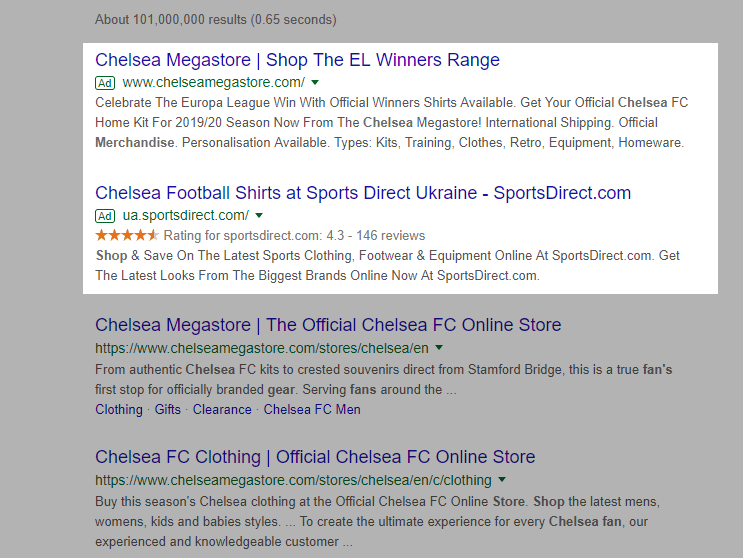
Email Marketing
This is a marketing approach based on communication via email. This type of internet advertising is one of the oldest players on the field and the most adaptive one since email marketers are always searching for innovations such as recently launched interactive amp emails.
You may personalize, segment, and A/B test your email campaigns to better target your audience.
Let's make email advertising work!
Generate more subscribers with professional subscription forms and move them down the sales funnel by sending relevant email campaigns with SendPulse.
Email marketing is the least obtrusive platform for advertising because subscribers willingly opt-in to receive email newsletters and promotions; plus, they can opt-out anytime. The main idea of email marketing is to drive warm marketing leads to the website, mixing promotions with valuable non-sales content.
Social Media Ads
This means advertising on socials like Facebook, Instagram, Twitter, Pinterest for B2C, and LinkedIn for B2B. Companies tailor their news and promotions to the target audience via social media in two ways:
- Organically. If you produce kitchenware, you can post valuable content like hacks, exciting ways of using your products, or some recipes to encourage shares and build an attractive brand image.
- Paid. In this case, you can use social media functionality for business by showing promotional posts targeted to your audience based on age, gender, favorite activities, and other things they have in common.
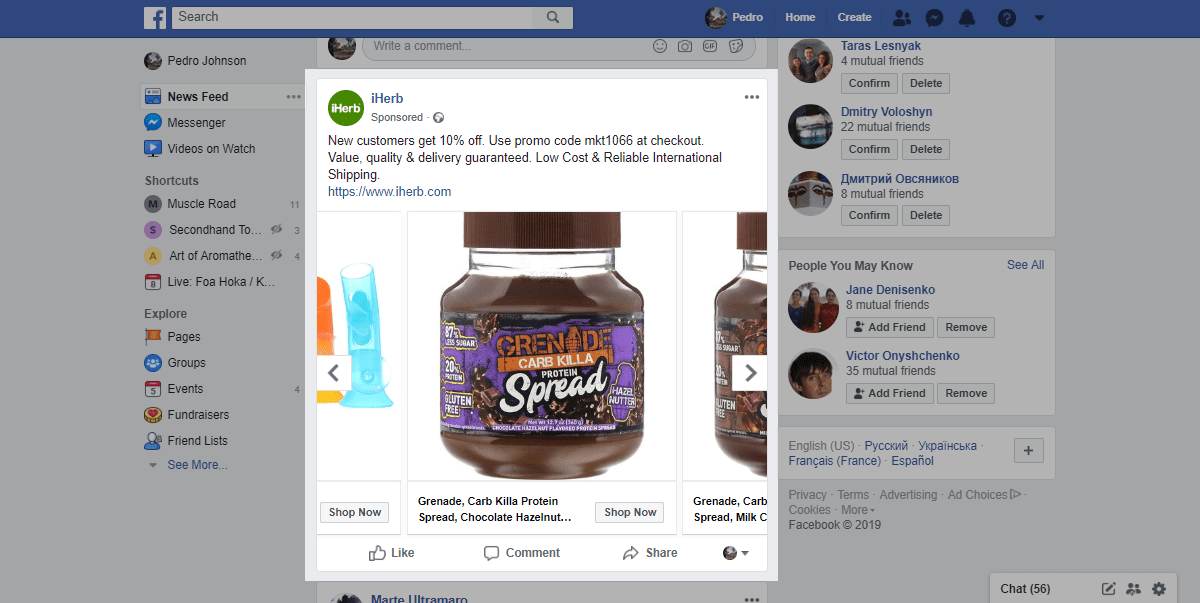
Display Ads
40% of Americans avoid banner ads, wallpapers, pop-ups, flash, and video ads with ad-blocking software due to the unsolicited nature of display advertising. Furthermore, many non-blockers unconsciously ignore the information in the ads because of a psychological phenomenon called “banner blindness.” Since the mid-1990s, display advertising has gained a negative reputation for being annoying media. Unless ads are highly relevant to the user, they are largely ignored or worse, totally invisible via ad-blockers.
Website owners with massive traffic to their site want to monetize it, so they sell some of their space with Google AdSense, while the advertisers buy it with Google Ads. Google shows relevant ads based on two pricing approaches: CPC (cost per click) and CPM (cost per thousand views), and allows companies to retarget their promotions.
The ads below are targeted by geographical location and may be interesting for the locals. The website below is from a newspaper based in California.

Native Advertising
In a way, this is a non-irritative alternative to the display ads. Companies pay popular sites like BuzzFeed, Bored Panda, and the New York Times for placing promotion materials in their publications. As long as it happens in an entertaining and casual manner, the readers don’t realize they’ve actually been advertised to — that’s why this phenomenon is called “native.”
It’s like putting a replica of the stone in the Japanese stone garden: no one knows it’s plastic because it looks natural. The example below is nominal, since any of these articles may contain plastic stones.
Video Advertising
As the name suggests, these ads are in a video format and placed on services like YouTube, Vimeo, DailyMotion, and Vine. This is an expensive type of advertising but also an effective one, since high-quality videos may go viral. A video advertising campaign called “Save The Ocean” encourages people to join the company that aims to reduce water pollution.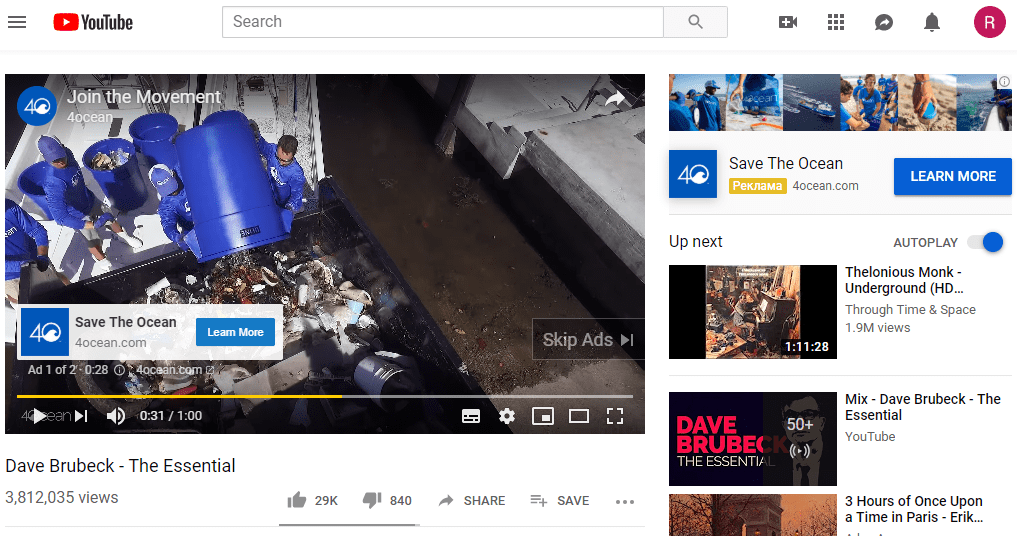
Web Push
This technology allows you to grab users’ attention whenever they are online. These messages appear in the corner of your screen, and a click on it redirects a user to a particular webpage. For example, a coffee shop can send you a morning notification about the 20% discount for making an order before 10 am. Users subscribe to push notifications to stay in touch with the brand and be the first to know the news and updates.
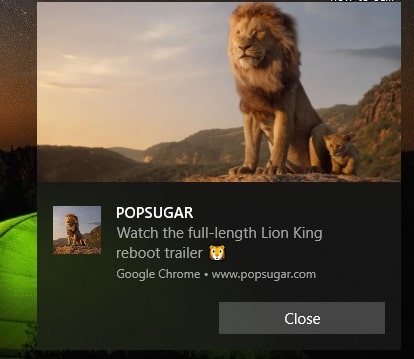
Mobile Advertising
This type of advertising appears on smartphones and tablets. Companies can advertise with SMS after the user opts-in or with display ads in the browser optimized for mobile devices. If you run a shoe shop, mobile ads are especially good for advertising to the local audiences with the time-sensitive offers. You can create SMS campaigns in no time with SendPulse, and their open rate is extremely high: up to 98%.

How can I advertise for free on the Internet?
Small businesses falsely believe that any type of online advertising is too expensive for them. We want to dispel this myth. There’re lots of effective advertising formats that require no investment. Check them out.
- Optimize your site for search engines. People all over the world are doing Google searches every second. They are looking for news, products, recipes, manuals, housekeeping hints, and much more. You can satisfy their interest and bring in new customers. Conduct some basic keyword research and pick up low-competition queries to start your SEO. On our blog, we outlined an SEO strategy that will bring your site to the top of the search.
- Send email campaigns. With their help, you can educate your customers, promote your products, share news and updates, keep clients informed about their orders, and increase brand recognition. All this and more is possible for free with SendPulse Email Service. If you have up to 500 subscribers on your mailing list, you can send them 15,000 emails every month for free.
- Write guest posts. Find authoritative blogs with a large audience that may be interested in your products. Offer them a valuable piece of content, share tips, provide case studies, and give advice. Link back to your website, and you’ll give a boost to your domain authority. This way, you’ll communicate your message to the target audience and increase your brand awareness.
- Utilize the power of social media. There’re at least two reasons that you should use them: most of the platforms are free, and people look for brands on socials. If you’re on a tight budget, advertising campaigns are not a must. Create your brand's profile, add photos and videos of your products, share news on recent updates, and ask for customer feedback. In addition, you can create a chatbot for Facebook Messenger to answer clients’ FAQ and help them place their order. SendPulse offers an intuitive and free chatbot builder.
- Start your blog. A blog is a place where you can demonstrate your expertise and promote your brand at the same time. Post regularly to share news about your company, educate your audience, give expert tips, and show some behind-the-scenes. You can even earn money from your blog by posting high-quality content from other companies that may be useful for your audience.
These five methods of advertising online for free are just the tip of the iceberg but proved in practice. Try them out!
How much does internet advertising cost?
- Search engine ads
- Email marketing
- Social media
- Display ads
- Native ads
- Video advertising
- Web push ads
- Search engine ads. The average cost per click across all industries is $2.32. This price depends on the keyword volume — how many times a month people search for a specific word or phrase, the level of competition, meaning how many companies use this keyword, and how high the bid for the ad rank based auction.
- Email marketing. The average price for 2,000 subscribers start at $27, 5,000 — $47, 10,000 — $69 and 50,000 — $253. You can send up to 15,000 emails to 500 subscribers each month for free with SendPulse. The service allows you to create email templates and send trigger emails, and lots of other handy features.
- Social media. Depending on the industry, Facebook's average CPC is $1.86, and CPM is $11.20. On Instagram, the average cost-per-click is between $0.50 - $1.00. In more competitive industries like apparel or law, the cost of ads can reach $3.00 per click.
- Display ads. The ad’s size and its placement on the webpage form the pricing together with the display period and the average amount of visitors. You shouldn’t necessarily choose Google Ads — you can use other services like Microsoft Advertising, Quora, AdRoll, etc., or contact website owners directly.
- Native ads. The main reason to utilize native advertising is the large amount of traffic that the company placing ads drives to its website. It is the most expensive type of online advertising because it demands high-quality content from the advertiser, hence professional copywriting, storytelling, editing, and design. It is highly efficient, though, due to the easy-to-digest nature of native ads.
- Video advertising. Companies pay YouTube on a pay-per-view basis. Typically, video ads cost between $0.10 and $0.30 per view, which means that you will pay $1,000 for 10,000 people to watch your ad. Another meaningful factor is video production. The cost here depends on how many people work on the video and how much they charge.
- Web push ads. You can utilize this feature for sending rapid promotions and updates for free in SendPulse.
- Mobile marketing. The cost for each SMS is $0.022 in the USA. SendPulse allows sending SMS on 800 networks in over 200 countries.
Internet Advertising Tips
- Analyze your ROI
- Segment your audience
- Choose the best media for a specific business
- Use social media platforms that are popular
- Be creative with your ads
- Use a clear call to action
- Make mobile-friendly ads
- Analyze your ROI. It is easy to ensure your efforts are worth a while with internet marketing. Check all the possible metrics depending on the type of digital marketing you use. Analyze open rate and CTR in email marketing, and use Google Analytics for your social marketing efforts and search engine marketing.
- Segment your audience. Separate your audience into different groups with something in common like age, gender, and location, and find the right approach for all of them. If you create a display ad campaign for clothing, make sure the message you tailor to women differs from the one for men.
- Choose the best media for a specific business. If you make and sell vegan food, use socials for promoting and receiving orders. Appearance in the local directories in Google search results may also address potential clients to you when they google “vegan food near me,” for instance.
- Use social media platforms that are popular. If your audience consists mainly of young people 14-30 years old, Instagram is likely the most commonplace for their communication with each other. Facebook is preferable for adults, so the best practice here is to examine your audience, their habits, and global tendencies to make the right choice.
- Be creative with your ads. Internet advertising is about catching people’s attention, so make your ads expressive and relevant. Bolster your creativity with bright colors and huge headlines, but avoid using all caps.
- Use a clear call to action. There's little time to get your message across to the audience, so make it clear what you want. Use a short and unambiguous CTA like “Book now,” “Learn more,” “Grab the promo code,” etc., depending on the business and the advertising goal.
- Make mobile-friendly ads. Preview all the ads you produce on a mobile phone to make sure they work since the majority of site visits are registered from smartphones.
Internet Advertising Examples
Below is an example of pay-per-click advertising. It means that an advertiser pays a fee to an ad network each time users click the link. PPC ads are located at the top of the search engine results page.
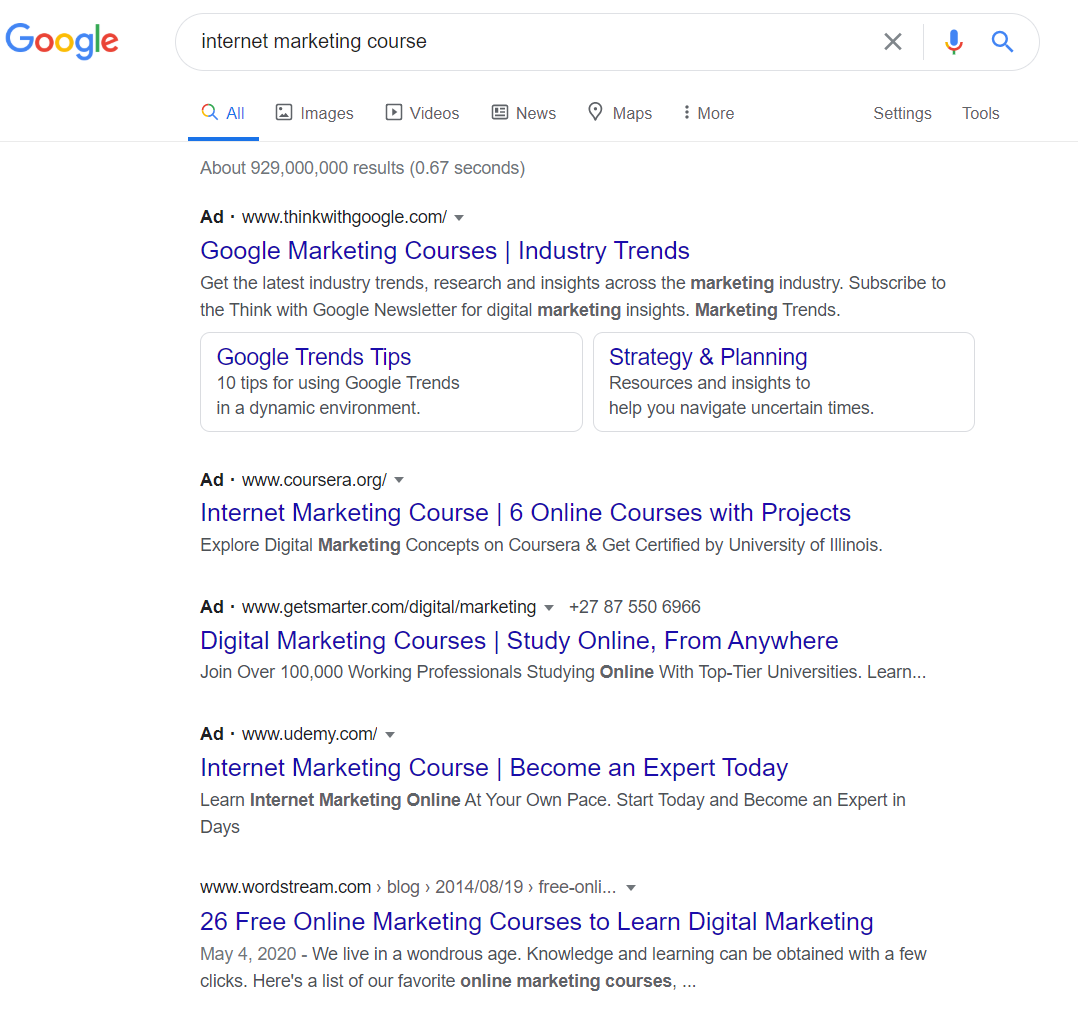
Mac sent this email to advertise their hot deal. The brand offers seven top-selling products for the low price of $63.

Lots of brands use social channels for brand promotion. GoPro advertises its products via one of the most trendy channels — Instagram. They use videos and user-generated photos to show the quality of their cameras.
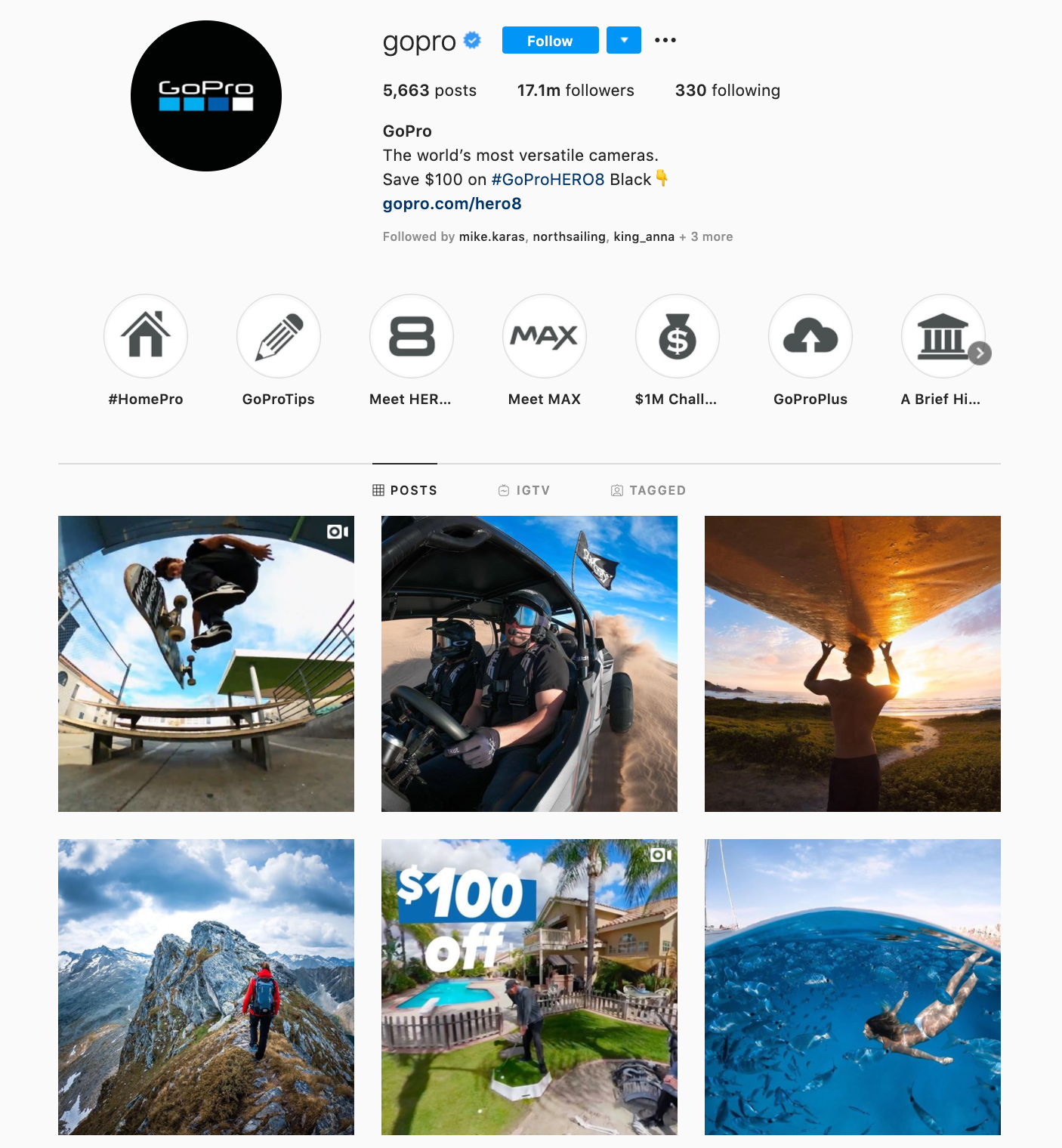
References
- This HubSpot article, "Online Advertising: Everything You Need to Know in 2019," builds a holistic view of the online advertising types. It considers the most popular channels and highlights KPIs to measure.
- This WordStream article "Online Advertising: How to Create Effective Online Advertising" explains online advertising types.
- The article "Online advertising" on Wikipedia covers its types and channels, explains how to measure its performance, and highlights the benefits.
FAQ
? How is SendPulse useful for internet advertising?
SendPulse is a multichannel marketing platform that allows you to send all sorts of marketing emails, SMS, web push notifications, and communicate with your audience via chatbots in messengers. Register with SendPulse and boost your sales with internet advertising.
⚙️ How does internet advertising work?
Tech giants like Google and Facebook collect tons of data about billions of users and create convenient, highly targeted tools for connecting buyers with sellers. Besides, internet advertising can be adjusted for any communication platform, be it email, SMS, social media, messengers, or push notifications. All this makes it easy to contact your target audience and promote your products and services via the internet.
? How can I advertize on the internet for free?
With SendPulse, you can send up to 15,000 emails to up to 500 recipients monthly and unlimited web push notifications to up to 10,000 subscribers for free. Besides, you can create free subscription forms, and chatbots in Facebook Messenger. Register with SendPulse and take advantage of free internet advertising.
? How has internet advertising changed?
Before the early 2000s, internet advertising was chaotic and spammy, until the governments began regulating it with laws, like the CAN-SPAM Act of 2003. Since then, marketers must get user permission to advertize via channels like email, SMS, messengers, or push notifications. Moreover, massive competition for user attention made businesses switch to a customer-centric approach. As a result, internet advertising is more personalized and relevant than ever before.
Last Updated: 09.07.2024


or